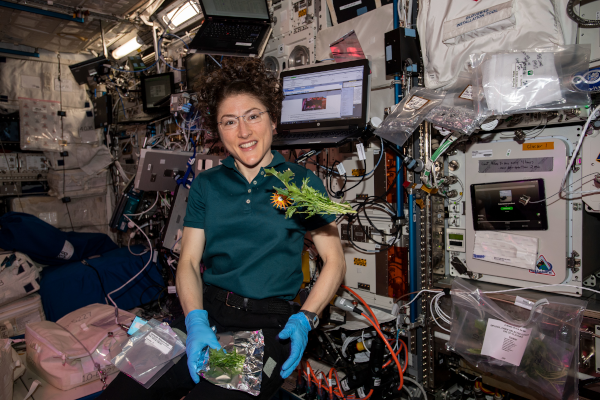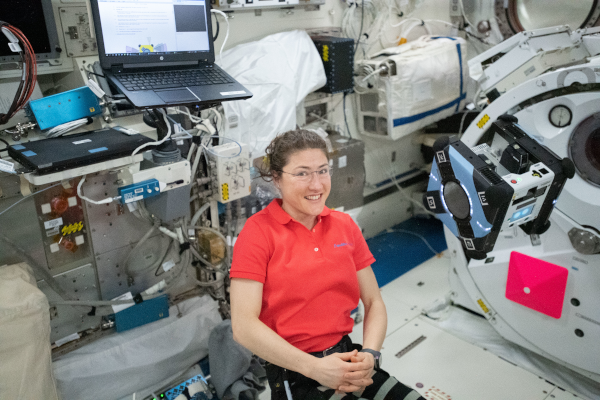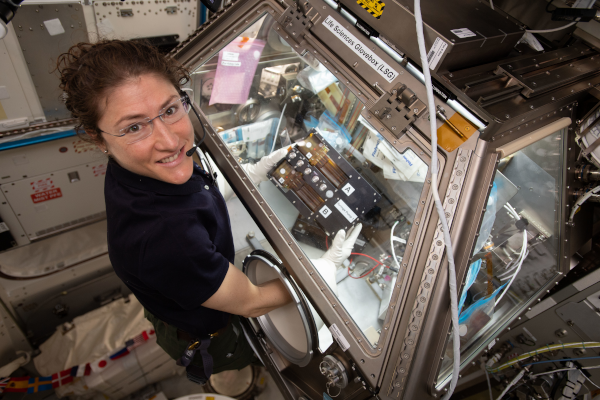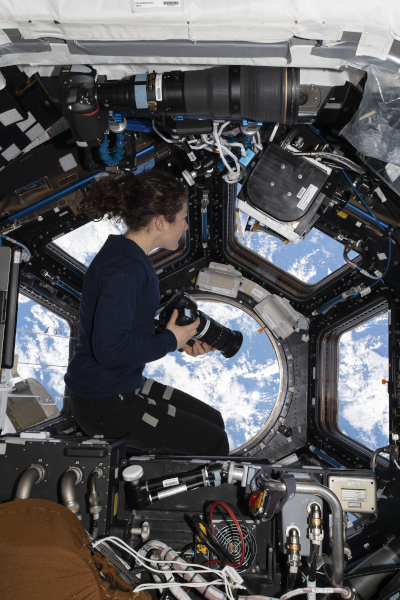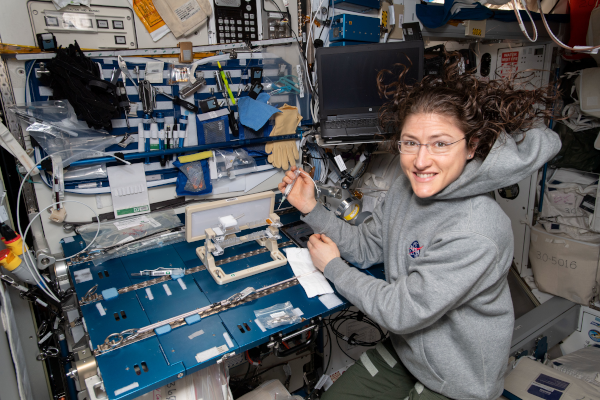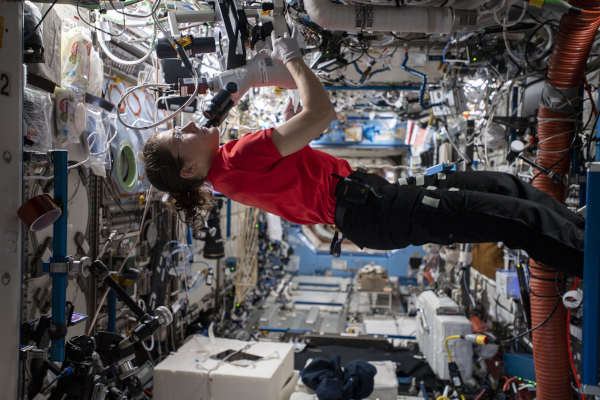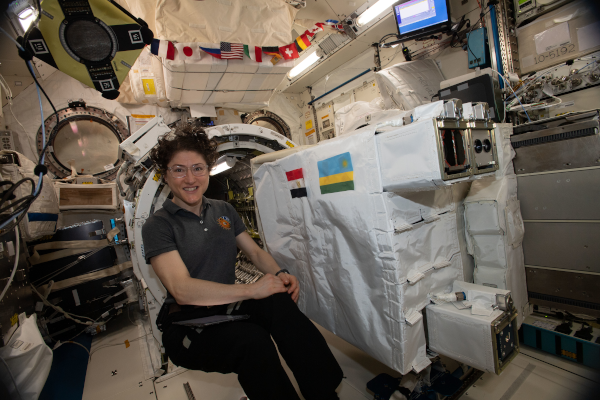The big science of NASA astronaut Christina Koch's near-year in space in photos
NASA astronaut Christina Koch will return to Earth Thursday (Feb. 6) after spending 328 days on the International Space Station — a new record for the longest single spaceflight by a woman.
After almost a year in space, Koch has conducted numerous science experiments on the orbiting lab, including studying the effects of microgravity on Mizuna mustard greens, combustion, bioprinting and kidney diseases.
In addition to her science experiments on the space station, Koch's extended mission will allow researchers to study the effects of long-duration spaceflight on a woman. This research will benefit future missions to the moon under the Artemis program and Mars.
You can watch Koch's return to Earth tonight on Space.com, courtesy of NASA TV. She will land in a remote part of Kazakhstan on a Soyuz capsule with crewmates Luca Parmitano of the European Space Agency and Alexander Skvortsov of Russia's Roscosmos agency. Live webcasts begin at 9 p.m. EST (0200 GMT), with landing scheduled for 4:14 a.m. EST (0914 GMT).
Here's a look at Koch’s record-setting mission in science photos.
Related: Expedition 61 mission to the International Space Station in photos
Koch frequently grew leafy greens during her time on the orbiting lab to study the effects of microgravity on plant biology. This research will also help engineers develop improved sustainable biological life-support-systems, according to a statement from NASA.
Breaking space news, the latest updates on rocket launches, skywatching events and more!
Koch is photographed here packaging some of the Mizuna mustard greens to be stored in a science freezer for analysis on Earth. In addition to studying the plants, the crew also got to taste test some of the fresh greens.
Koch monitored a test of three cube-shaped, free-flying machines called Astrobees. The trial was conducted in Japan's Kibo laboratory module of the space station. These autonomous robots are designed to help astronauts with routine tasks, such as chores or finding lost pieces of equipment. They will also collect data as they float around the space station, giving ground controllers additional eyes and ears on the space station to help monitor the crew and environment of the orbiting lab.
In this photo, Koch is working on Advanced Combustion via Microgravity Experiments (ACME), which consists of five different studies of how fire behaves in space. These experiments take place in the Combustion Integrated Rack (CIR), in the Destiny lab on the space station.
The purpose of this research is to provide a better understanding of spacecraft fire safety and the combustion process, which, in turn, will help researchers improve fuel efficiency and reduce pollutants produced during combustion on Earth. The crew on the space station sets up each experiment, which are run by scientists at NASA’s Glenn Research Center in Cleveland, Ohio.
Koch also studied kidney cells onboard the space station. She is photographed here using the Life Sciences Glovebox to examine how kidney health is affected by microgravity and other factors of space travel, such as diet, water conservation and recycling. This work will help researchers develop innovative treatments for kidney stones, osteoporosis and toxic-chemical exposures.
Osteoporosis and kidney stones are caused by poor kidney health. Therefore, this research could benefit astronaut health during future long-duration missions, as well as humans needing kidney-related treatment on Earth.
Koch is pictured here floating through the space station with science hardware called the Cold Atom Laboratory, an experimental instrument that produces clouds of atoms chilled to temperatures of about one ten billionth of a degree above absolute zero.
"At these low temperatures, atoms have almost no motion, allowing scientists to study fundamental behaviors and quantum characteristics that are difficult or impossible to probe at higher temperatures," NASA officials said in the statement.
The space station's seven-windowed Cupola observatory, also known as the Window to the World, allows astronauts the opportunity to observe Earth from a unique vantage point. Here, Koch is photographing landmarks as the orbiting lab fles 259 miles (417 kilometers) above the Pacific Ocean off the coast of South America.
Astronauts also use the Cupola to make "valuable Earth observations such as unexpected weather events, which robotic sensing platforms cannot capture," according to the statement from NASA.
Koch also worked on the Capillary Structures experiment, which tests a new method for separating liquids and gases for more reliable life-support systems for the space station and future space missions.
"Capillary systems can be simpler to use than current water-purification and air-cleaning systems because they rely on specific geometric shapes and fluid dynamics rather than complex machinery," according to NASA.
This research could also be used to improve water recovery systems or desalination plants on Earth.
As part of the Microgravity Crystals experiment, Koch studied protein crystal samples grown in the microgravity of the space station. She is seen here using a microscope to observe and photograph the growing protein crystals, which are larger and more organized than those grown on Earth under the influence of gravity, according to the statement from NASA.
Understanding how microgravity affects the growth of protein crystals can benefit various areas of research, including how to develop and manufacture products like pharmaceuticals.
During Koch's stay on the space station, the BioFabrication Facility was installed. This instrument will be tested for its ability to print organ-like tissues, which would represent a major step toward making human organs in space.
"The orbiting laboratory is a great place to perform this type of research because printing the tiny, complex structures found inside human organs, such as capillary structures, may be done easier in microgravity since it has proven difficult so far to accomplish in Earth’s gravity environment," NASA officials said in the statement.
Koch is photographed here with the BioFabrication Facility, which launched to the space station on July 25, 2019, aboard a SpaceX Dragon cargo spacecraft.
Koch is photographed here with a new small-satellite deployer developed by Japan, Rwanda and Egypt. She worked inside Japan's Kibo laboratory module on the space station to set up the deployer, which was placed inside Kibo's airlock. The space station's Japanese robotic arm was used to move the deployer from the airlock. Once the deployer was outside, it released three cubesats into Earth orbit.
In addition to the many experiments Koch worked on, she was also a research subject herself. She participated in the Human Research Program experiment, which studies astronauts' health. This study will allow researchers to develop improved strategies for individual and team performance, and ensure astronauts maintain healthy immune systems in space. In this photo, Koch is storing samples for the research program, which will be further tested on Earth.
Having spent 328 days in space, Koch surpassed the previous record of 288 days set by NASA astronaut Peggy Whitson in 2017. Koch launched to the space station on March 14, 2019 for what was expected to be a six-month mission. However, her stay was extended by NASA in April 2019, and she will now return home Wednesday, Feb. 5.
- Record-Breaking astronaut Christina Koch talks female space records and more
- Historic women spacewalkers hope to land on the moon
- Kelly Clarkson just called 2 NASA astronauts in space. Here's what they said (video)
Follow Samantha Mathewson @Sam_Ashley13. Follow us on Twitter @Spacedotcom and on Facebook.


Samantha Mathewson joined Space.com as an intern in the summer of 2016. She received a B.A. in Journalism and Environmental Science at the University of New Haven, in Connecticut. Previously, her work has been published in Nature World News. When not writing or reading about science, Samantha enjoys traveling to new places and taking photos! You can follow her on Twitter @Sam_Ashley13.
